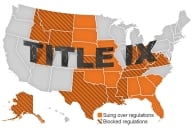You have /5 articles left.
Sign up for a free account or log in.
There has been much discussion recently over the plight of liberal arts colleges in the new global century. The closure of some institutions, the deep financial challenges faced by others that are tuition-driven, and the fiscal constraints at liberal arts colleges with traditionally large but now battered endowments, all raise questions regarding the future of this sector of higher education. Perhaps more controversially, some observers have identified the addition of professional and vocational programs to the curriculum at liberal arts colleges as a long-term threat to the focused mission and intellectual well-being of these institutions.
But while economic challenges may pose a threat to the viability of some small to medium-sized liberal arts colleges, there is really nothing new about this phenomenon. As historians of higher education have pointed out, the mortality rate for small baccalaureate colleges has been high throughout the nation’s history. From tiny sectarian colleges on the frontier, to campuses where the curriculum was too small, to underfunded institutions that perished with their founders, the story is as varied as it is persistent.
The more troubling claim about the fate of liberal arts colleges, it seems to me, involves the argument that the addition of professional and applied fields including business, engineering, communications, or health and wellness, somehow dilutes the core values of a liberal arts education. This argument appears to center on the notion that the liberal arts experience is largely defined by academic majors, and that only by remaining pure to an arbitrary constellation of allied fields can the uniqueness of the liberal arts college experience be preserved.
I would like to suggest that a different paradigm may be in order, one that acknowledges the simple fact that residential liberal arts colleges have always been attuned to the imperatives of professional and vocational life. Europe’s earliest medieval universities were all about the practical, dare we say “vocational” needs of the universal Roman Catholic Church. When students at Bologna began the study of law in the late 12th century, one suspects they had a modicum of interest in getting on with their careers.
The 17th-century English philosopher John Locke graduated Christ Church College, Oxford in 1656. But he also took a medical degree and employed his training to save the life of his future patron, the political operative Anthony Ashley Cooper, first earl of Shaftesbury. And it was under the employ of Shaftesbury that Locke wrote what would later be published as Two Treatises of Government, a text that proved to be of some value to leaders of the American Revolution like Thomas Jefferson. Locke found no incongruity between his liberal education and his more practical studies. Why do we?
The future of the liberal arts college, in my view, is secure so long as administrators, faculty leaders, and innovative boards continue to reject the antithesis between liberal arts and professional studies. One emerging sector in higher education is doing just that. The Council of Public Liberal Arts Colleges (COPLAC) is a consortium of 26 state-supported institutions committed to a high quality, largely residential liberal arts education. One way these colleges are different from some more traditional private liberal arts colleges is that the publics, without reservation, offer majors in business and communications and other fields, while also taking pride in their majors in biology and classics and English.
Admittedly, most of us do not associate liberal arts education with public universities. Much more familiar is the former state teachers’ college, the large land-grants, the comprehensives, and the sprawling Research I campuses. COPLAC colleges and universities have chosen another path. For COPLAC, a quality liberal arts education is about small class size, close faculty-student interaction, an innovative and interdisciplinary common core in the arts and sciences, undergraduate research experiences, senior capstone projects, service learning and community engagement, and a rich and diverse co-curricular life. Moreover, faculty members from professional programs at COPLAC institutions fully support and engage in this unified experience.
Some years ago, I was teaching in an interdisciplinary core humanities program at a COPLAC member institution. At their weekly meeting, the 12-person faculty team was discussing the upcoming common reading. The topic was the Industrial Revolution and the common reading was Marx’s Communist Manifesto.
As a historian, I went into the session thinking that I should lead the discussion. But as things turned out, the most perceptive insights into the text, and how to teach the text, came from a wonderful colleague in management and accountancy. In describing the shock horror that thinkers like Marx must have represented to the self-confident industrialist of the mid-19th century, it was a professor of management who brought the liberal arts experience into sharper focus, both for his colleagues and, more importantly, for his students.
The resiliency of the liberal arts college has been demonstrated across many generations, and with the addition of a growing public liberal arts sector to reaffirm the value of broad-based learning in a small campus setting, the future offers great promise. We should applaud, not criticize, liberal arts colleges that respond to the growing demand for skilled professionals in a variety of applied fields. These graduates will bring to their work the habits of critical inquiry and the integration of knowledge -- both liberal arts outcomes -- that serve to temper the narrow instrumentalism often found at the center of our professional lives.








